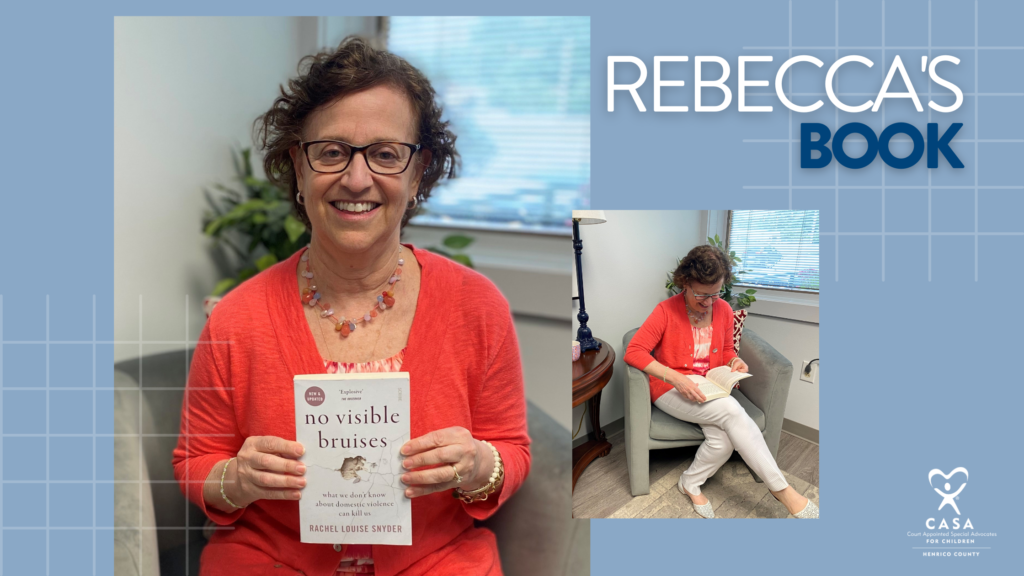
Our team at Henrico CASA loves to read… and there’s no better time to read than the summer! In upcoming weeks we’ll be highlighting some of our recent favorites in the hopes that you will enjoy the themes and connections to our work as child advocates.
Synopsis
As Amazon explains, “In No Visible Bruises, journalist Rachel Louise Snyder gives context for what we don’t know we’re seeing. She frames this urgent and immersive account of the scale of domestic violence in our country around key stories that explode the common myths―that if things were bad enough, victims would just leave; that a violent person cannot become nonviolent; that shelter is an adequate response; and most insidiously that violence inside the home is a private matter, sealed from the public sphere and disconnected from other forms of violence. Through the stories of victims, perpetrators, law enforcement, and reform movements from across the country, Snyder explores the real roots of private violence, its far-reaching consequences for society, and what it will take to truly address it.”
If that doesn’t spur your desire to read this book, perhaps Parul Sehgal’s reflection in the New York Times will: “In its scope and seriousness — its palpable desire to spur change — this book invites reflection not only about violence but about writing itself. What kinds of reportage really move policy? What kinds of narrative — what sorts of tone, structure, examples — can stoke a reader’s outrage and then translate that outrage into action, keeping it from curdling into cynicism or despair?”
I Recommend Because…
I chose this book for our summer reading program after having already read it several months ago. If you know very little about Domestic and Intimate Partner Violence, you will quickly become knowledgeable. On the flipside, if you are already well-versed, you will find some clarity about aspects of the abuser’s and of the victim/survivor’s behavior. For example, why a victim doesn’t leave the abuser is very well explained in this book. The author also offers in-depth information about the abuser using data, research, interviews, observation, and the personal experiences of abusers and victims to describe what is going on in the power and control relationship.
I recommend this book to all CASA-connected readers. Here are some highlights:
- We often hear: “Why didn’t she (the victim) leave the abuser?” How come we never hear, “Why was he so violent? Why couldn’t he stop the violence?” Why victims stay is not the question to be answered. We know that answer. How to protect is the question.
- I now have another question that I want the helping system, including the criminal justice system, to pivot toward. That more relevant question is: “We can try to protect her, but why can’t we make him leave her alone even after being tried and convicted? Why can’t we make the abuser stop?”
- Domestic violence is a process but our criminal justice system is set up to address incidents, not processes. Although we can predict that there will be more incidents, we cannot punish prospective behavior.
- Evidence based prosecution should be our goal, rather than witness based prosecution. When the police include photos, affidavits, witness testimonies, prior records, or 911 tapes it’s less likely that the victim will have to testify in front of the abuser. (In my work at CASA, I have come to appreciate that Henrico County Police aim for this!)
In addition, as one prosecutor reports, “If you can get eight or nine charges out of one incident, it’s a better shot that she won’t have to take the stand and he’ll plead on some of those.” If there are drug charges, illegal weapons in the home, kidnapping, preventing a 911 call, or other charges, there’s a better chance of conviction without the victim’s participation or testimony.
- Another highlight of the book is from a former predatory abuser called Jimmy. Among many insights from Jimmy is one called, “fatal peril”. Four behaviors can lead to fatal peril:
Denial – “I didn’t do it.”
Minimization – “I only hit her once” or “But she came at me first.”
Blame – “She was in my face.”
Collusion – another guy (or his own past) telling the abuser, “You gonna let her talk to you like that?”
This book solidified my passion for supporting victims and the children who witness the violent acts that leave ‘no visible bruises.’








